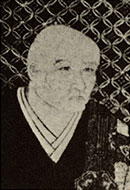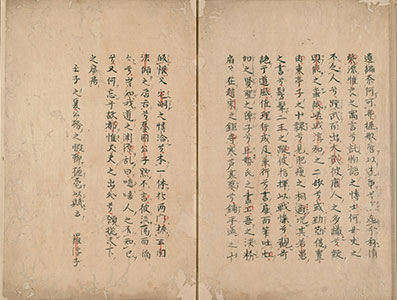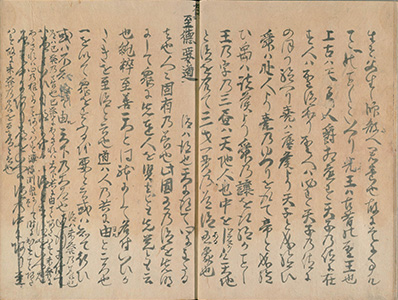Chapter 1 The statesmen and their entourage Brains of the early Edo period
Brains of the early Edo period
KANSHITSU Genkitsu, 1548-1612
 A Buddhist monk from the Rinzai sect, who was active from the Muromachi to Edo periods. Kanshitsu served as the ninth principal of the Ashikaga Gakko (Ashikaga School), which was the equivalent of a university in medieval Japan. He later became the founder of Enko-ji temple. Other than being in charge of the “Fushimi edition” (which is considered to be one of the most important editions in the history of Japanese publication) by order of Tokugawa Ieyasu, his major achievements include administrative work with the Korean ambassadors and involvement in administration regarding temples and shrines.
A Buddhist monk from the Rinzai sect, who was active from the Muromachi to Edo periods. Kanshitsu served as the ninth principal of the Ashikaga Gakko (Ashikaga School), which was the equivalent of a university in medieval Japan. He later became the founder of Enko-ji temple. Other than being in charge of the “Fushimi edition” (which is considered to be one of the most important editions in the history of Japanese publication) by order of Tokugawa Ieyasu, his major achievements include administrative work with the Korean ambassadors and involvement in administration regarding temples and shrines.
2 Jusen wakan koto hennen gounzu, [Yobo-ji temple], [1600][WA7-12]
The old-movable type edition of a chronicle of both China and Japan from ancient times up to 1600. It is a type-printed book from the early 17th century and is considered to be one of the most important editions in the history of Japanese publication. A handwritten note by Kanshitsu can be seen at the end of the last page of the first volume (inserted part), which reads, “two copies of Nendai-ki (chronicle) were granted from Shogun”. In Enko-ji yuishogaki, the history of Enko-ji temple, which Kanshitsu became the founder of, there is a record of Tokugawa Hidetada giving Nendai-ki to Kanshitsu, which elucidated that this “Shogun” refers to Tokugawa Hidetada.
 Book collections previously owned by Enko-ji temple Kyoto
Book collections previously owned by Enko-ji temple Kyoto
These books are from the collections of the Kanshitsu Genkitsu, the founder of Enko-ji temple and the head priests of the temple who succeeded him. The collection holds approximately 400 titles and 1,300 books, most of which are Buddhist writings. It includes many manuscripts written by Kanshitsu himself as well as books with additional notes handwritten by him. Not a few books in the collection were granted from Shoguns such as Tokugawa Ieyasu and Hidetada.
Enko-ji temple was a Rinzai sect Buddhist temple founded in 1601 and located in Fushimi, Kyoto. Tokugawa Ieyasu provided books to Enko-ji temple and had them establish a school.
HAYASHI Razan, 1583-1657
 A Confucian scholar from the early Edo period, who studied under the tutelage of Fujiwara Seika. He was the teacher for the first four Shoguns of the Tokugawa Shogunate, from Ieyasu to Ietsuna. Razan also served as a political advisor to the Shogunate.
A Confucian scholar from the early Edo period, who studied under the tutelage of Fujiwara Seika. He was the teacher for the first four Shoguns of the Tokugawa Shogunate, from Ieyasu to Ietsuna. Razan also served as a political advisor to the Shogunate.
3 Honcho hennenroku, [early Edo period][WA17-9]
The overview of Japanese history put together by order of the Shogunate and written by Hayashi Razan in Chinese and in chronological style. The inserted material indicates the part from 834 to 839 A.D. Razan’s subordinates edited this part under his supervision, and it was completed in 1650.
A fu (prose poetry in Chinese) about the history of Japan titled Wa-fu was attached to the last page of this book. Wa-fu was also included in the opening part of Razan’s complete works (published 1662). It seems to be written in Razan’s own hand.
KUMAZAWA Banzan, 1619-1691
 A Confucian scholar from the early Edo period. He was a pupil of Nakae Toju. Gaining trust from Ikeda Mitsumasa, the lord of the Okayama Domain, Banzan delivered successful results in countermeasures for disasters and famines. On the other hand, there were many criticisms against Banzan at the same time, and he eventually retired in 1657. Banzan dedicated the final years of his life to writing, but was imprisoned for his political criticism and died of illness.
A Confucian scholar from the early Edo period. He was a pupil of Nakae Toju. Gaining trust from Ikeda Mitsumasa, the lord of the Okayama Domain, Banzan delivered successful results in countermeasures for disasters and famines. On the other hand, there were many criticisms against Banzan at the same time, and he eventually retired in 1657. Banzan dedicated the final years of his life to writing, but was imprisoned for his political criticism and died of illness.
4 Kokyo shokai, [early Edo period][WA17-17]
An explanatory book on Kokyo, one of the classics of Chinese Confucianism, it is written in plain Japanese. Nakae Toju, the teacher of Banzan, had written Kokyo keimo in Japanese for his wife, and it is believed that Banzan was inspired by it. This is one of his works written in his later years.
The inserted material has suffered various forms of damages including water damage, resulting in characters on the left page being torn away and sticking to the right page face down.








